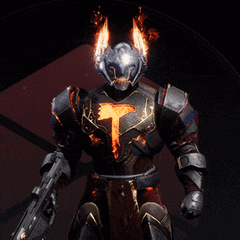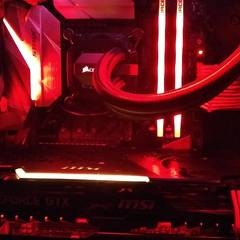-
Posts
1,262 -
Joined
-
Last visited
Reputation Activity
-
 Quaker got a reaction from AbdullahTrees in Upgrade Ideas, Please
Quaker got a reaction from AbdullahTrees in Upgrade Ideas, Please
Any build can be improved, but I'd suggest that adding an additional 4Gigs of RAM would be the best "budget" improvement.
-
 Quaker got a reaction from Bananasplit_00 in Looking for a min 400W max 550W PSU with a 14 pin connector.
Quaker got a reaction from Bananasplit_00 in Looking for a min 400W max 550W PSU with a 14 pin connector.
A 14-pin connector? That must be some sort of odd-ball proprietary connector. Older ATX form factor motherboards used 20-pin connectors, and now use 24 pins. I would assume that any 'standard' power supply would only have the usual 20/24-pin connector. The 14-pin ones would probably be propriatary and expensive.
In any case, there should be no problem using an adapter PROVIDED that you are sure that the adapter is designed to work with your particular motherboard. Given that the 14-pin isn't 'standard', there could be several variations of pin layout.
-
 Quaker got a reaction from Stefan Payne in Why have a +600 Watt PSU in ITX Factor?
Quaker got a reaction from Stefan Payne in Why have a +600 Watt PSU in ITX Factor?
Efficiency curves differ because circuit design, components, etc, varies between different models/brands.
Yes, less heat is generated at higher efficiency because less power is wasted internally. (duh)
However, there is no reason to assume that a particular 1Kwatt PSU would be more efficient at a particular load.
A 1Kwatt PSU that is 85% efficient at 400watts output would produce the same amount of heat as a 500watt PSU that is 85% efficient at 400watts output. Note - this is the total quantity of heat, not the temperature of any particular part.
-
 Quaker got a reaction from bowrilla in Why have a +600 Watt PSU in ITX Factor?
Quaker got a reaction from bowrilla in Why have a +600 Watt PSU in ITX Factor?
Actually electricity (in electronic circuits) has everything to do with heat. It's the consumption of electricity that produces the heat. What did you think causes the heat in a resistor - magical pixies?
(And, of course, it's not just resistors that have "resistance" and/or generate heat.)
The 400watts that the power supply would be delivering (in this hypothetical case) is the power consumed by the components - CPU, motherboard, GPU, etc - and would not be the source of the heat produced within the power supply.
The heat produced within the PSU is the result of the power consumed within the PSU itself in order to deliver that 400watts. In this hypothetical case, an 80+ power supply would be drawing 500 watts out of the wall in order to deliver 400watts output. It's that extra 100watts of power consumed that generates the heat within the PSU.
Whether the 80+ power supply is capable of delivering 1Kwatt or only 500watts, at 400watts output there would be 100watts of wasted power. This wasted power is essentially turned into the same quantity of heat.
The components in a 550 watt power supply could be just as capable of withstanding this heat as the components in a 1000watt supply.
The level of noise produced by a power supply would be a function mostly of the cooling system. A 1Kwatt power supply generally has, as you said, larger heatsinks, etc, and so can often deliver lower levels of power without even turning on the fan, but, it is, of course also possible to build a lower wattage power supply with larger heaksinks so it's fan doesn't run as often either. There are even some passively cooled power supplies that have no fan at all.
Generally speaking, it comes down to a price/performance issue. It's possible to build power supplies with all manor of cooling systems that develop more or less noise based upon the internal components and the quality, size, etc, of the fan (if any).
-
 Quaker got a reaction from Imbellis in Why have a +600 Watt PSU in ITX Factor?
Quaker got a reaction from Imbellis in Why have a +600 Watt PSU in ITX Factor?
This is not entirely true. If your system is consuming say, 400watts, your 1000watt PSU needs to work just as hard as 550watt one does, to produce that 400watts. You can also get passively cooled, lower wattage, power supplies that are quiet all the time.
Unless you actually need 1000watts - which would basically mean a highly overclocked system with 3 or 4 way SLI/CFX - it is very un-economical price/performance-wise to get a 1000watt psu.
And before you talk about "efficiency" - you'll need to run your computer for a long, long time to recoup the added expense of a larger (or gold rated) power supply's extra initial cost.
In any case - in answer to the original poster - they make 800watt SFX PSUs because people will buy them. People buy them because they (mistakenly) think more watts is better. Given the current power draw of most ITX systems, very few people would ever need more than a 650watt power supply.
(I for example, am using a 650watt ATX power supply in my ITX build because I'm running an older, power hungry R9 390. If I was using a GTX-10xx, I'd need less).
(And yeah, I know, there's going to be someone who talks about their ITX system with an overclocked X99 system, etc, etc, or some special situation involving a custom build, but ... )
EDIT - My bad - I misread the original post as 800 watts instead of 600 watts. There are of course, many situations where you could use a 600watt SFX power supply. For example, building a system in a Node 202 case with an AMD Vega graphics card.
-
 Quaker got a reaction from Alex90uk in help me trouble shooting this, either GPU or PSU I think?
Quaker got a reaction from Alex90uk in help me trouble shooting this, either GPU or PSU I think?
These problems are usually caused by a flaky power supply or motherboard - particularly bad "bulging" or leaking capacitors in either unit.
Try borrowing a different power supply (for testing).
Inspect the motherboard for signs of leaking or bulging capacitors.
Of course, any part of the motherboard or PSU could be flaky, so direct replacement is the best troubleshooter.
-
 Quaker got a reaction from Zando_ in My laptops internet died
Quaker got a reaction from Zando_ in My laptops internet died
I was recently working on fixing a friends laptop when the wifi stopped working. After spending some time running around in circles trying to find the answer, I discovered that I had accidentally turned the wifi off by hitting a "WiFi disable" switch on the side while trying to open the optical drive.
So, does the laptop have a WiFi disable switch, either separately somewhere on the body, or as a function on the keyboard?
-
 Quaker got a reaction from Artechz in Laptop Frame-Rate Issues
Quaker got a reaction from Artechz in Laptop Frame-Rate Issues
Make sure the system is using the 940m and not the Intel IGP (if that;s even possible).
-
 Quaker got a reaction from Drake10114 in Micro-AtX Cases on the cheap
Quaker got a reaction from Drake10114 in Micro-AtX Cases on the cheap
This Rosewiil case has top mounted I/O which may be convenient for floor mounting. (And it's only $30)
https://www.newegg.ca/Product/Product.aspx?Item=N82E16811147255
-
 Quaker got a reaction from 4klips in How to work with components inside the case?
Quaker got a reaction from 4klips in How to work with components inside the case?
The simplest thing is to do is to touch something metal that's grounded every now and then if you think you may actually build up any static.
One simple way to do that is to plug the power cable into the power supply and then touch the case of the power supply. (Provided that the 3-prong plug on the power cable is plugged into a properly connected 3-prong outlet.) The power supply does not have to be "ON" or even connected to anything to be grounded.
-
 Quaker got a reaction from Beedyboy in Looking for upgrade tips and opinions.
Quaker got a reaction from Beedyboy in Looking for upgrade tips and opinions.
There's not really anything that needs to be upgraded and the benefits of any upgrade would probably not be worth the expense.
You didn't mention what sort of SSD you have, other than that it's 240 Gig. You could upgrade to a 500Gig NVME M.2 SSD.
Or, you could get rid of that ugly case and/or "upgrade" (more of a lateral shift) to Ryzen.
But seriously, you could satisfy your "build it" impulse by putting together a system for someone else. Or build an entirely new mini-ITX system for grins.
-

-
 Quaker got a reaction from i_build_nanosuits in FX-8350 Bottlenecks my GTX 980?
Quaker got a reaction from i_build_nanosuits in FX-8350 Bottlenecks my GTX 980?
The FX line of CPUs never were good for gaming (unfortunately).
-
 Quaker got a reaction from SwervinPersian in Hobby Build
Quaker got a reaction from SwervinPersian in Hobby Build
I'd suggest that the best way to start a "hobby" build would be to buy one of the many used, cheap i5 business computers with a mini-tower (not slimline) case. Just make sure it has a PCIe x16 graphics card slot.
You can then do things like adding a a cheap graphics card such as a GTX-1050 or RX 460, upgrading the RAM, upgrading the power supply, etc.
-
 Quaker got a reaction from Heesleemer in E5-2620 V4 thoughts & usage (8 core broadwell xeon)
Quaker got a reaction from Heesleemer in E5-2620 V4 thoughts & usage (8 core broadwell xeon)
You really only need an i7-6700K or i7-7700K - which will give you 8 "threads". There's no real need to go to some exotic Xeon build to save a few minutes occasionally.
I'd suggest you "flip" the Xeon (and it's motherboard) and buy an i7-7700K with a Z270 (or H270) motherboard. You may find that the i7-7700K actually works better than the Xeon (for Adobe rendering).
-
 Quaker got a reaction from Jahoppski in USB Ports NZXT Noctis 450
Quaker got a reaction from Jahoppski in USB Ports NZXT Noctis 450
As said above, you would normally plug things like your mouse, keyboard, and bluetooth dongles into the USB ports on the motherboard (which end up on the back of the case.)
-
 Quaker got a reaction from DailyProcrastinator in Is ATX needed on z170/z270??
Quaker got a reaction from DailyProcrastinator in Is ATX needed on z170/z270??
ATX form factor goes back to the days where you had separate network, sound, and other cards, so you needed the extra space for the expansion slots. You also need the extra space for PCIe slots to do 3 and 4-way SLI/Crossfire.
Most motherboard these days come with a network adapter and sound built in, so most people don't need ATX motherboards any more. MicroATX motherboards even have room for 2-way SLI.
If you are just building a common system for gaming, and don't plan to SLI, you can even use mini-ITX. (But there are restrictions on the number of RAM slots, etc.)
Note that an mATX (or mini-ITX) motherboard will fit into most full-size ATX cases. (The mounting holes are standardized)
Some people seem to think that they have to get an ATX motherboard for an ATX case and/or an mATX case for a mATX motherboard. You can't put a larger ATX motherboard into a smaller mATX case, but there's no problem the other way around.
So, my answer would be - no, there's very little need for full-size ATX motherboards any more.
-
 Quaker got a reaction from done12many2 in 6800k Stock Voltage High?
Quaker got a reaction from done12many2 in 6800k Stock Voltage High?
If resetting the BIOS or "loading defaults" doesn't cure the issue, It could also be a bad motherboard, or the motherboard's BIOS/UEFI may need to be updated.
-
 Quaker got a reaction from Pwnzu001 in Need some help with my old bessy
Quaker got a reaction from Pwnzu001 in Need some help with my old bessy
What to upgrade first might depend a bit upon what apps and games you run. But, if you upgrade the CPU first, the R7 240 can still be used at low graphics settings.
Unless you are in a hurry to upgrade, I'd suggest you wait for Kaby Lake and/or Ryzen to be released.
For a KL (or Skylake) or Ryzen upgrade you will need a CPU, motherboard and DDR4 RAM.
-
 Quaker got a reaction from MacAaroni in New Build after 4.5 years
Quaker got a reaction from MacAaroni in New Build after 4.5 years
At this point you should wait for Kaby Lake and a (more moderately priced) Z270 motherboard. It won't be a big difference, but it is the latest.
(The Asus Z170-Deluxe is overkill unless you plan to heavily overclock or need some of the features. A mid-range Z170/270 motherboard will handle a 'normal' overclock.)
-
 Quaker reacted to Starelementpoke in Upgrading my RAM from 8GB
Quaker reacted to Starelementpoke in Upgrading my RAM from 8GB
Any of those work, but you probably won't need more than 16GBs. Just get another 2x4.
-
 Quaker got a reaction from MehdiAliii in Case
Quaker got a reaction from MehdiAliii in Case
The Dell XPS 8900 appears to have a standard ATX power supply, so it should fit. It definitely isn't too big, so the only question would be the location of the mounting holes, which are probably either standard, or 'drill-able'.
-

-
 Quaker reacted to iRileyx in Im proudly done
Quaker reacted to iRileyx in Im proudly done
No need to pay $50 for a cooler when the stock cooler will be just fine for a 6400, save the money and put it towards a 6500, SSD, or better power supply.
The power supply isn't the "worst" but it could definitely be better, and recommended that you do go for a better one.
-
 Quaker got a reaction from jeremymwilson in Non Gaming-centric Build
Quaker got a reaction from jeremymwilson in Non Gaming-centric Build
No, you shouldn't overclock unless you are "into it". But, if you do, you can probably just use a basic CM Hyper 212 instead of liquid cooling, unless you want to go to a very high overclock.
You don't need a 6-core processor. The only thing that would do for you would be to reduce the render times of your occasional video edits. It's not worth the extra expense unless you do editing on a daily basis and have time constraints (e.g. pro or semi-pro).
I'd suggest :
- i7-6700 or 6700K
- Either the stock cooler or a CM Hyper TX3 - or a CM hyper 212 if you want to OC.
- A motherboard with a B150 or H170 chipset - or Z170 if you want to overclock. There are various motherboards available with a USB-C connector. You should also get one with an M.2 connector.
- A 250-500 Gig SSD for the OS and apps - preferably M.2 PCIe
- A GTX-1070 graphics card. If you do try any gaming, you will need a good graphics card to drive those displays.
- 16Gigs of DDR4-2133 or 2400 (2x 8Gig)
- Corsair CX550M power supply
- Windows 10 Home 64-bit.
For a case, get whatever floats yer boat, as they say. You can get anything from a full ATX tower to an mATX mid tower, to a mini-ITX case such as the Corsair 250D. Just be sure to get a motherboard that fits the case.












-min.thumb.jpg.6bb5bb869faad807bbf55550a4fe15d2.jpg)


